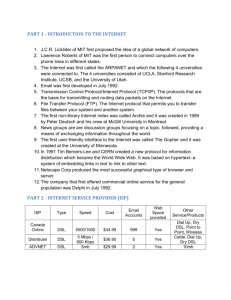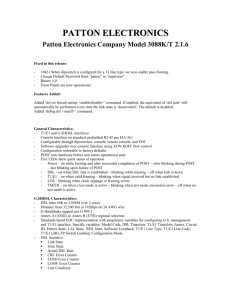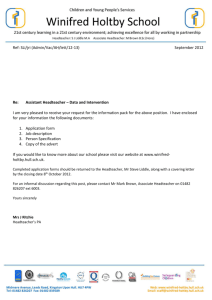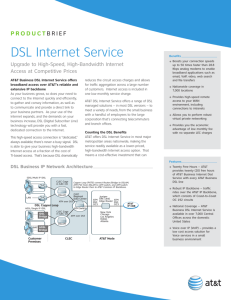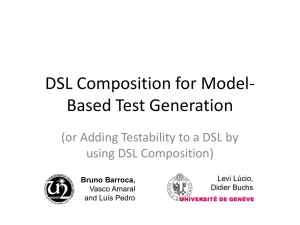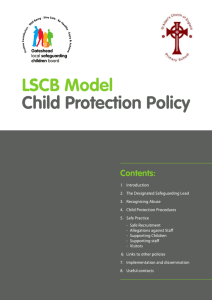Children`s Safeguards Service: LEA Exemplar Policy
advertisement
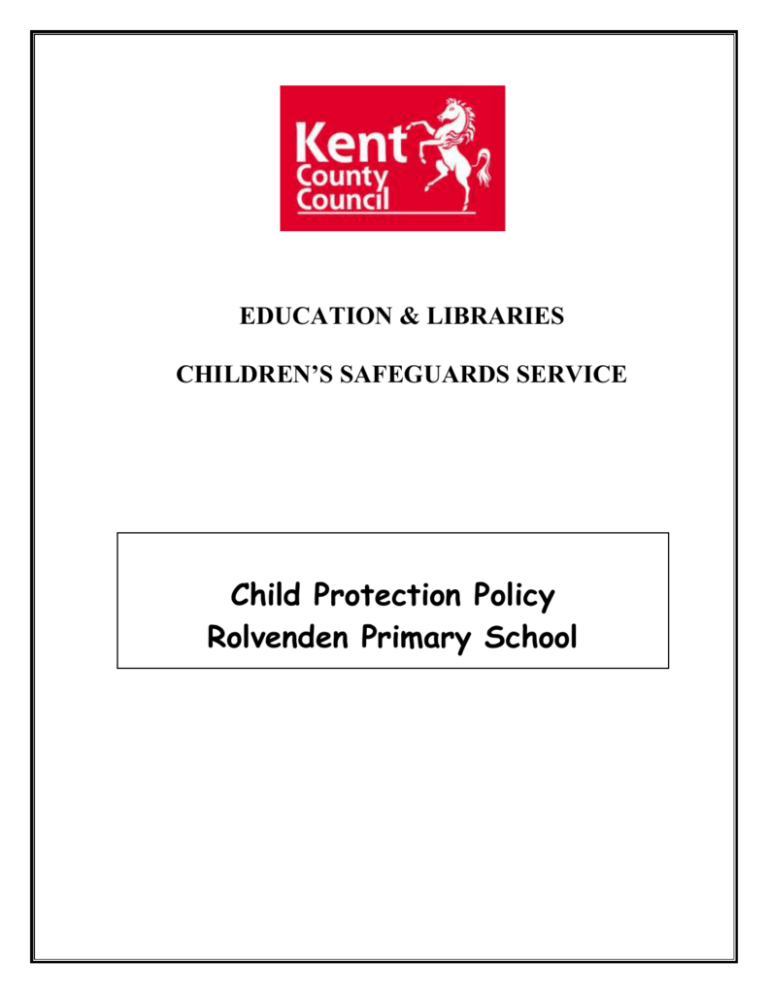
EDUCATION & LIBRARIES CHILDREN’S SAFEGUARDS SERVICE Child Protection Policy Rolvenden Primary School Child Protection Policy Statement ROLVENDEN PRIMARY SCHOOL CONTENTS Child Protection Policy Statement Page no Introduction and aims 3 Roles and responsibilities School Designated Safeguarding Lead 3 General strategies 4 Procedures Recognition and categories of abuse Responding to concerns Record keeping Information to be recorded Storage of records Referrals to Social Services Child Protection Register Concerns involving members of staff 5,6,7 Code of Practice 8 Supervision and support 8 Training 8 Monitoring and Review 8 Appendices 2 INTRODUCTION: This policy has been developed in accordance with the principles established by the Children Act 1989, Sections 175 and 176 Education Act 2002 and related guidance including The Framework for the Assessment of Children in Need and their Families and Working Together to Safeguard Children. The Governors and staff of Rolvenden Primary School take seriously our responsibility to promote the welfare and safeguard all the children and young people entrusted to our care. The Designated Safeguarding Lead (DSL) who has overall responsibility for child protection practice in school is Mrs Anita Rivers As part of the ethos of the school we are committed to: Maintaining children’s welfare as our paramount concern Providing an environment in which children and young people feel safe, secure, valued and respected; confident to talk openly and sure of being listened to Providing suitable support and guidance so that students have a range of appropriate adults who they feel confident to approach if they are in difficulties Using the curriculum to provide opportunities for increasing self awareness, self esteem, assertiveness and decision making so that students have a range of contacts and strategies to ensure their own protection and understand the importance of protecting others Working with parents to build an understanding of the school’s responsibility to ensure the welfare of all children including the need for referral to other agencies in some situations Ensuring all staff are able to recognise the signs and symptoms of abuse and are aware of the school’s procedures and lines of communication Monitoring children and young people who have been identified as “in need” including the need for protection; keeping confidential records which are stored securely and shared appropriately with other professionals Developing effective and supportive liaison with other agencies ROLES AND RESPONSIBILITIES: School: The school is responsible for ensuring that all action taken is in line with Kent’s Child in need/child protection procedure. This process implemented in April 2001 follows the requirements of the central government guidance contained in the Framework for Assessment of Children in Need and their Families and Working Together to Safeguard 3 Children. The child protection process is now incorporated within a comprehensive policy and procedure for all children in need. The role of the school within this procedure is to contribute to the identification, referral and assessment of children in need including children who may have suffered, be suffering or who are at risk of suffering significant harm. The school may also have a role in the provision of services to Children in Need and their families. All adults in school have a role to play in relation to: Protecting children from abuse Promoting the welfare of children Preventing children from being harmed The role of the school in situations where there are child protection concerns is NOT to investigate but to recognise and refer. Designated Safeguarding Lead: The Designated Safeguarding Lead is responsible for: Co-ordinating child protection action within school Liaising with other agencies Ensuring that locally established procedures are followed including reporting and referral processes Acting as a consultant for staff to discuss concerns Making referrals as necessary Maintaining a confidential recording system Representing or ensuring the school is appropriately represented at inter-agency meetings in particular Child Protection Conferences Managing and monitoring the school’s part in Child care / protection plans Organising training for all school staff Liaising with other professionals GENERAL STRATEGIES: This section gives an opportunity for staff to identify the specific ways in which child protection issues are addressed within the curriculum, policies and guidance or through school/community initiatives. This may include: PHSE Behaviour Management Policy Safe School initiative Peer mentoring Community initiatives Anti-Bullying Strategies Care Plans/Education Plans 4 Pupil Councils (consultation/children’s rights) Complaints Procedures Health and Safety Risk Assessments Extra Curricular Activities PROCEDURES: A copy of Kent’s Child in need/child protection procedure is kept in the staff room and contains details of procedures and the categories and definitions of abuse. All staff are advised to read Chapters 4 and 5 of this handbook. A copy of the Assessment Framework can also be found in the staff room. Recognition and categories of abuse: All staff in school should be aware of the definitions and signs and symptoms of abuse. There are four categories of abuse. These are: Physical abuse Sexual abuse Emotional abuse Neglect The signs and symptoms of abuse are listed in a leaflet distributed to all staff in January 2004 and displayed on the staff room notice board. A Child in Need / child protection resource pack containing a range of information is available for staff from the DSL. A copy of the DOH guidelines “What to do if You’re Worried A Child Is Being Abused” is also available to staff. Responding to concerns: Concerns for a child or young person may come to the attention of staff in a variety of ways for example through observation of behaviour or injuries or disclosure. Any member of staff who has a concern for a child or young person however insignificant this might appear to be should discuss this with the DSL as soon as is practically possible. More serious concerns must be reported immediately to ensure that any intervention necessary to protect the child is accessed as early as possible. 5 If a child makes a disclosure of abuse to a member of staff they should: Allow the child or young person to make the disclosure at their own pace and in their own way Avoid interrupting except to clarify what the child is saying (attentive listening/reflective feedback) Not ask leading questions or probe for information that the child or young person does not volunteer Reassure the child or young person that they have been heard and explain what you will do next and to whom you will talk Record the conversation as soon as possible Inform the DSL Record keeping: Staff can play a vital role in helping children in need or at risk by effective monitoring and record keeping. Any incident or behavioural change in a child or young person that gives cause for concern should be recorded on an incident sheet copies of which are kept in the Headteacher’s office. It is important that records are factual and reflect the words used by the child or young person. Opinion should not be given unless there is some form of evidence base which can also be quoted. Records must be signed and dated with timings if appropriate. It is important to remember that any issues are confidential and staff should know only on a ‘need to know’ basis. Information to be recorded Child’s name and date of birth Child in normal context, e.g. behaviour, attitude, (has there been an extreme change) The incident(s) which gives rise for concern with date(s) and times(s) A verbatim record of what the child or young person has said. If recording bruising/injuries indicate position, colour, size, shape and time on body map. Action taken These basic details are vital to the information gathering process and do not constitute an investigation. Written information should be passed to the DSL. The Headteacher should always be kept informed of any significant issues. 6 Storage of records: The DSL will ensure that records relating to concerns for the welfare or safety of children are kept separate from other school files and are stored securely. Information will be shared on a strictly need to know basis and in line with child protection policy guidance. Referrals to Social Services: It is the responsibility of the DSL to decide when to make a referral to the Social Services Directorate. To help with this decision s/he may choose to consult with the Area Children’s Officer (Child Protection). Advice may also be sought from Social Services who offer opportunities for consultation as part of the Child in need / child protection process. Issues discussed during consultations may include the urgency and gravity of the concerns for a child or young person and the extent to which parents/carers are made aware of these. Some concerns may need to be monitored over a period of time before a decision to refer to Social Services is made. In all but the most exceptional cases parents/carers will be made aware of the concerns felt for a child or young person at the earliest possible stage and in the event of this becoming necessary, their consent to a referral to Social Services will be sought. Referrals to Social Services will be made using Kent’s inter-agency referral form. In situations where there are felt to be urgent or grave concerns a telephone referral will be made prior to the form being completed and sent to the County Duty social services office. If a child or young person is referred, the DSL will ensure that the Headteacher and other relevant staff are informed of this. If after consultation with the DSL a member of staff feels that appropriate action is not being taken in respect of his or her concerns for a child s/he should refer directly to Social Services. The Headteacher should be informed of this decision. The child protection register The DSL will inform members of staff who have direct pastoral responsibility for children and young people whose names are on the child protection register. These children and young persons must be monitored very carefully and the smallest concern should be recorded on an incident sheet and passed immediately to the DSL or the Headteacher in the DSL’s absence. Concerns involving members of staff: Any concerns that involve allegations against a member of staff should be referred immediately to the Headteacher who will contact the Area Children’s Officer (Child Protection) to discuss and agree further action to be taken in respect of the child and the member of staff. 7 Further information regarding the procedure for managing situations involving members of staff, the Headteacher or the DSL can be found in the Child Protection Procedures for Managing Allegations Against Staff. Copies of this document are held by the Headteacher and DSL. All staff need to be aware that it is a disciplinary offence not to report concerns about the conduct of a colleague that could place a child at risk. When in doubt – consult. (For specific guidance on how to respond to allegations against staff, please refer to the Child Protection Procedures for Managing Allegations Against Staff). CODE OF PRACTICE: All school staff should take care not to place themselves in a vulnerable position with relation to child protection. It is always advisable for interviews or work with individual children or parents to be conducted in view of other adults. Physical intervention should only be used when the child is endangering him/herself or others and such events should be recorded and signed by a witness. Staff should be aware of Kent’s Positive Handling Policy and the school’s own Behaviour Management Policy, and any physical interventions must be in line with agreed policy and procedure in which appropriate training should be provided. All school staff should work towards providing an environment and atmosphere for children and young people to enable them to feel safe to talk. However, staff should never promise a child to keep certain information confidential. It must be explained that staff have certain duties to help keep that child safe, which may involve informing others. SUPERVISION AND SUPPORT: Any member of staff affected by issues arising from concerns for children’s welfare or safety can seek support from the DSL. All newly qualified teachers and classroom assistants have a mentor or co-ordinator with whom they can discuss concerns including the area of child protection. The DSL can put staff and parents in touch with outside agencies for professional support if they so wish. Staff can also approach Support Line directly. TRAINING OPPORTUNITIES: The DSL is responsible for ensuring staff including him/herself receive training in the area of child protection. The LEA’s Children’s Safeguards Service provide training to all schools in the roles and responsibilities of a School DSL and the Child in need/child protection procedure. 8 MONITORING AND REVIEW: All school personnel and governors will have a copy of this policy and will have the opportunity to consider and discuss its contents prior to the approval of the Governing Body being formally sought. This policy was been written in July 2011 to reflect the guidance and legislation issued in relation to safeguarding children and promoting their welfare within schools. The policy forms part of our school development plan and will be reviewed annually. All staff should have access to this policy and sign to the effect that they have read and understood its content. School: Headteacher DSL DSL DSL CP Governor LA (Children’s Officer) Most recent CP Training event CP Training Planned Rolvenden Primary School Mrs Anita Rivers Mrs Anita Rivers Miss Ellen Jones Mrs Julie Hodgkins Mrs Julie Hodgkins/ Mrs Sue Morgan Kate Davis Module 2 DSL 6-10-2010 Safer recruitment 14-06-12 All staff 10-05-12 Refresher DSL 2013 Reviewed: 24th January 2012 Reviewed by: AR/ Governing body Next review date: Spring 2013 Reviewed: Reviewed by: 9
